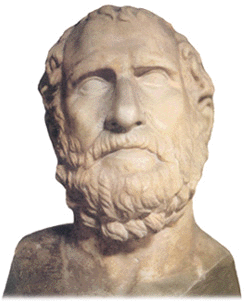...Best of Sicily presents... Best of Sicily Magazine. ... Dedicated to Sicilian art, culture, history, people, places and all things Sicilian. |
by Vincenzo Salerno | |||
Magazine Index Best of Sicily Arts & Culture Fashion Food & Wine History & Society About Us Travel Faqs Contact Map of Sicily
|
Tragically, not all of Aeschylus' tragedies have survived. The earliest one known to us is "Persians," first performed in Syracuse at the request of its ruler, Hieron I. This was followed, in 475 BC, by "Women of Etna," in honour of the refoundation of Catania. Aeschylus probably acted in some of his own plays, not an uncommon practice for writers in those days. In effect, people like Aeschylus were writer-director-actors, multi-talented in much the same manner as many of today's rap singers, who write, choreograph and perform. The Syracusan amphitheatre was a magnificent setting, and some of Aeschylus' plays are still perfortmed there each Spring and Summer. The largest Greek theatre anywhere constructed entirely of stone, it was then somewhat larger than the structure standing today. Of the Oedipus trilogy only "Seven Against Thebes" survives, but it is an inspired - and inspiring - work. Like the Orestia trilogy, it is a favourite for performances at Syracuse and Segesta today. (Yes, each Summer the original Greek tragedies are performed in Syracuse's ancient amphitheatre, and you don't have to be a scholar of Greek classics to enjoy them.) Written around 458 BC, Orestia includes "Agamemnon," (known by its original title), "Choephoroi" (The Libation Bearers) and "Eumenides" (The Furies). In the popular mind, "Prometheus Bound" may be his best remembered work. Percy Bysshe Shelley and Eugene O'Neill are just two modern writers influenced by Aeschylus' timeless dramas. He may not have created the artform, but Aeschylus certainly glorified it. In his hands, popular drama became exciting entertainment: a living art. Following Aeschylus' death, a "tyrant" (ruler) of Syracuse revered the dramatist's desk as a sacred object, almost a relic to be venerated. Aeschylus died in the Sicilian city of Gela around 455 BC following a career as one of the greatest dramatists of his age or any other. About the Author: Palermo native Vincenzo Salerno has written biographies of several famous Sicilians, including Frederick II and Giuseppe di Lampedusa. | ||
Top of Page |
 By some accounts, he was born in Athens. According to others, he was a
native of nearby Eleusis, where his father, Euphorion, was probably born. If little is known of his early life,
Aeschylus certainly left us a distinguished body of work created in his middle age spent in Greece and also here in
Sicily. Here he lived in
By some accounts, he was born in Athens. According to others, he was a
native of nearby Eleusis, where his father, Euphorion, was probably born. If little is known of his early life,
Aeschylus certainly left us a distinguished body of work created in his middle age spent in Greece and also here in
Sicily. Here he lived in